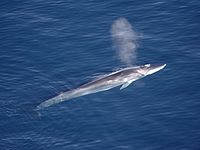
Photo from wikipedia
Blubber is a highly specialized and dynamic tissue unique to marine mammals and presents a reflection of the individuals' nutrition, environment, and life history traits. Few studies have investigated the… Click to show full abstract
Blubber is a highly specialized and dynamic tissue unique to marine mammals and presents a reflection of the individuals' nutrition, environment, and life history traits. Few studies have investigated the histomorphology of cetacean blubber in subtropical environments. The aim of this study was to investigate the blubber histomorphology of three different dolphin species off the subtropical KwaZulu‐Natal coast, South Africa, using adipocyte cell size, number, and density. Blubber tissue samples from the saddle area of 43 incidentally bycaught animals (four Sousa plumbea, 36 Tursiops aduncus, and three Delphinus delphis) were used to compare cell parameters between blubber layers. Samples were divided into the upper third (corresponding to the superficial layer closest to the epidermis), middle third, and lower third (corresponding to the deep layer). For T. aduncus, factors potentially affecting blubber histomorphology, such as sex, age class, and season, were also assessed. Our results showed that no stratification was present in S. plumbea, which could be ascribed to the species' warmer inshore habitat, large body size, and apparent lower mobility. For T. aduncus and D. capensis, however, blubber stratification was determined, characterized by a gradual transition of cell size, number, and density between layers rather than clearly defined layers. Significant differences in adipocyte cell number and density were found for different sexes and age classes of T. aduncus. However, there were no significant differences between seasons, which was attributed to the small temperature differences between seasons. This study represents the first investigation of odontocete blubber histomorphology in subtropical waters. It is recommended that future studies investigate blubber lipid content, while also taking into consideration the reproductive status of the females and the temperature range of their study area. It is hoped that our results, in conjunction with histopathology and other health indicators, could assist in assessing health and body condition.
Journal Title: Journal of Morphology
Year Published: 2022
Link to full text (if available)
Share on Social Media: Sign Up to like & get
recommendations!